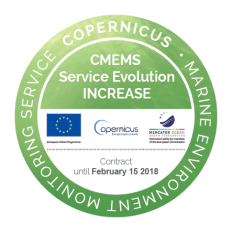
INCREASE
INNOVATION AND NETWORKING FOR THE INTEGRATION OF COASTAL RADARS INTO EUROPEAN MARINE SERVICES
Abstract
The accurate monitoring of surface transport, which is inherently chaotic and depends on the details of the surface velocity field at several scales, is key for the effective integrated management of coastal areas, where many human activities concentrate. This has been the driver for the growth of coastal observatories along the global ocean coasts. Among the different measuring systems, coastal High Frequency Radar (HFR) is the unique technology that offers the means to map ocean surface currents over wide areas (reaching distance from the coast of over 100km) with high spatial (a few kms or higher) and temporal resolution (hourly or higher). Consequently, the European HFR systems are playing an increasing role in the overall operational oceanography marine services. Their inclusion into CMEMS is crucial to ensure the improved management of several related key issues as Marine Safety, Marine Resources, Coastal and Marine Environment, Weather, Climate and Seasonal Forecast. In this context, INCREASE will set the necessary developments towards the integration of the existing European HFR operational systems into the CMEMS, following four main objectives:
- Provide HFR quality controlled real-time surface currents and key derived products ;
- Set the basis for the management of historical data and methodologies for advanced delayed mode quality-control techniques;
- Boost the use of HFR data for improving CMEMS numerical modelling systems;
- Enable an HFR European operational node to ensure the link with operational CMEMS.
Deliverable:
WP1 |
Towards the integration of HFR observing technology into CMEMSObjectives : Make a diagnostic of the present development of European HFR, set the methodology for specific processing and mapping of product uncertainties following world class processing and calibration/correction, and for reprocessing of existing data sets with advanced QC methods; Roadmap for the production of additional physical variables from HFR (wave, wind data) |
D1.1: Report on European HFR systems development and roadmap for HFR products evolutions in compliance with CMEMS needs |
WP2 |
Basis for HFR data assimilation into CMEMS modelsObjectives : to set the basis for HFR data assimilation into CMEMS models, following these two specific objectives of R&D objectives in area 4.3; O2.1 Development of a capacity to assimilation new/novel HFR observations; O2.2 Development of community tools and diagnostics |
D2.1 :Guidelines towards increasing HFR data assimilation capacities into CMEMS
|
WP3 |
HFR Products developmentObjectives :O3.1. Development of basic products to feed Insitu TACs; O3.2. Development of advanced products to feed Insitu TACs |
D3.1: Protocols on QA best practices, QC for radial and total data
D3.2: Tool for interoperable radial and total data production, tool for combination of radial data with different spatial resolutions |
WP4 |
HFR Node ObjectivesDesign and develop the hardware and software infrastructure for HFR data management; Develop and disseminate a common method for data formats, file conventions, file dimension, file naming and labelling for both real time and historical HFR data ; Set up THREDDS catalogues |
D4.1: Recommendation and guideline to set up the hardware and software tools to provide HFR data to the HFR Node
|
WP5 |
CoordinationObjectives :Ensure effective coordination and the deliverables/ milestones; To integrate the European expertise in the definition of products and methodologies; To ensure the coordination with CMEMS for boosting the impact and organizing future implementation; To promote the use of HFR data. |
D5.1 :Quarterly progress reports and plans for the next quarter D5.2 Mid-term report D5.3: Minutes D5.4: Final report |
 INCREASE HF Radar Experts Workshop (La Spezia, 15-16/9/2016)
INCREASE HF Radar Experts Workshop (La Spezia, 15-16/9/2016)

